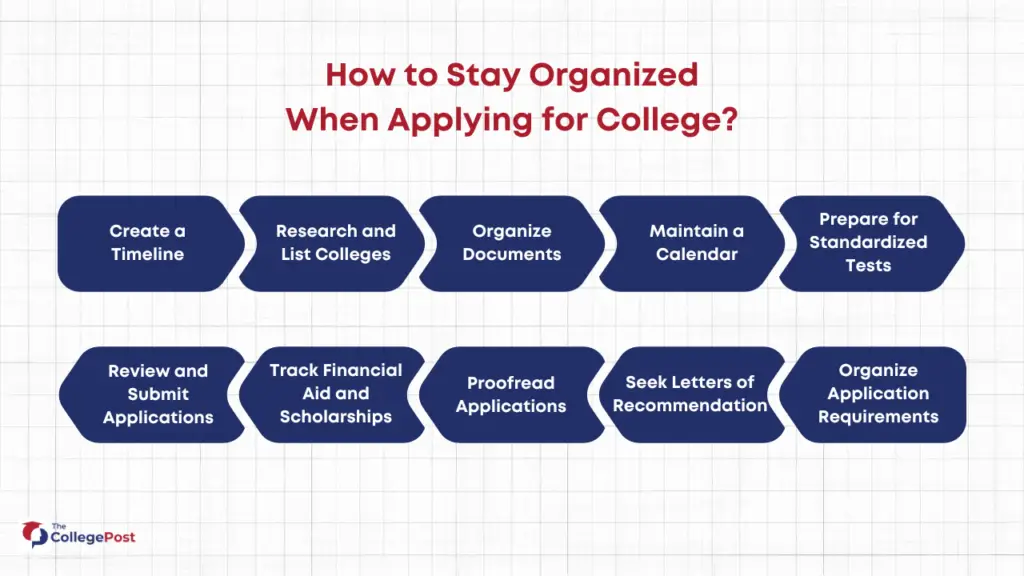You’ve done the hard work in high school, shown passion for extracurriculars, and crushed your exams. Now, it’s time to get ready for the next big move — applying for college! ✨🎓
Sure, there’s a lot riding on these applications, but it’s all about taking it step by step. Discover the nine steps that can boost your chances of getting accepted into your dream school.
Before you know it, you’ll learn how to apply for college, be strolling across the quad, ready to conquer the world! 💪

- 1. Create Your College List: Where Do You Want to Apply?
- 2. Make Your College Application Action Plan
- 3. Ace Your Standardized Tests
- 4. Receive Stellar Letters of Recommendation
- 5. Write Killer College Essays
- 6. Submit Your High School Transcript Requests
- 7. Check All the College Application Boxes
- 8. Pay Your College Application Fees
- 9. Cross Your Fingers!
- Optional Steps When Applying to College
- Using the Common App to Apply to College
- How to Stay Organized During the College Application Process
- How to Apply to College: Frequently Asked Questions
1. Create Your College List: Where Do You Want to Apply?
Ready to start applying for college? Let’s kick things off by figuring out where you want to go to school. 🙌
Organize your college options based on your chances of getting in — it’ll be like giving yourself a friendly nudge towards better odds of acceptance. Don’t forget to explore alternative schools as a backup plan in case things don’t go exactly as planned. 🤔
But if you’re still worried about whether or not you’re going to be accepted, turn to a college acceptance calculator rather than a crystal ball. 🔮
Based on your coursework, grades, extracurricular activities, class rank, test scores, and intended majors, a college acceptance calculator can help you sort possible colleges into three categories: safety, probable, and reach.

- Safety: The “hell yeah” category that includes colleges where you have a really good chance of getting accepted (80 percent or higher). They might not be your top pick, but they’ll be there for you if the others don’t work out.
- Probable: The “maybe” category where your odds of acceptance are between 30 percent and 80 percent. Your academic credentials are in the same ballpark as the school’s average for accepted students.
- Reach: The “I’m dreaming but it’s worth a shot” category where your odds of getting accepted are below 30 percent. It might seem like a long shot, but hey, anything can happen!
Now, some folks recommend applying to four to eight schools, but the total number of applications will be totally up to you. 🏫
TIP: Consider affordability, captivating extracurriculars, and distinctive programs to refine your college options and ensure customized applications to your desired schools.
Figure out what type of institution it is you want (whether public, private, or trade), then attend college tours to check if the culture, local scene, and academic standards are the right match.
2. Make Your College Application Action Plan
Now, it’s time to kick things up a notch. Create an overview of everything you need to do for the entire college application process, including a clear roadmap and timeline for each step. 📆
Let’s talk strategy: if you want to crush the college application game, you’re going to need a detailed to-do list.
Here are two key things to keep in mind when putting that list together:
List All Your Application Requirements
You have to know the exact application requirements you need to prepare for each college. This is the foundation of your action plan, so don’t skip this step! ✅
Here are common and essential ingredients that complete your college application masterpiece:
- Completed application form: A college application form asks for information about your academics, extracurriculars, and personal background. To ace this step, remember to be comprehensive and to proofread your application — don’t let simple mistakes slip through.
- Application fee: Colleges may charge an application fee, ranging from $50 to $100, which covers the purchase and maintenance of the online application system, as well as the price of examining applications.. A portion of the fee is also used to cover fee waivers for applicants from low-income families.
- High school transcripts: These show off the impressive classes you’ve taken and highlight your grades to admissions officers. Make sure to request them early, double-check the deadline for each school on your list, and remember to submit these on time.
- Standardized tests: Despite more and more schools moving toward test-optional policies, submitting strong test scores can enhance your application and demonstrate academic aptitude.
- Letters of recommendation: Request recommendation letters from one or two teachers who know you well and can speak favorably about your academic strengths and personality. It’s best to give them plenty of time to think it over and make the letter, so ask at the end of 11th grade.
- Personal essay: Expect to write a 300 to 500-word essay (sometimes two) on a chosen topic to help the selection committee know who you are beyond your GPA and test scores.
- Supplemental resume: This shows what you’re passionate about and what you’ve accomplished — include a brief description of each activity, how long you participated, and any leadership roles held or awards received.

Note Your Application Deadlines
Some college applications can be more demanding because they feature complicated sections or require tough-to-get documents. 📋
This means that deadlines will not be the same for all the schools you’re eyeing. To make sure that your efforts are not wasted, keep track of these important dates in your mobile (or actual) calendar. 📱
The first step is to check the college’s website and find its specified college application deadline. From there, you can plan your moves several months to a year in advance to ensure a well-organized and stress-free college application.

Note: Consider when you want to apply for college — during early, regular, or rolling admissions — and see if the schools you’re applying to offer all these options.
Due to less competition, early applications boost your chances of being accepted to college, whereas rolling admissions offer shorter response times and support in weighing several acceptance possibilities.
You can use the following timeline as a model to make sure your applications are filed on time:
| January to April (Junior Year) | Prepare for AP exams in MayPlan ACT or SAT test datesSchedule college campus visits |
| May (Junior Year) | Take AP examsRequest letters of recommendation |
| June to August (between Junior and Senior Year) | Take the final ACT or SATOpen a Common App account (if you’re using the app)Start brainstorming and drafting your personal essay on the Common AppComplete your college campus visits |
| September (Senior Year) | Ask for feedback and finish your personal essay on the Common AppFinalize your list of college optionsRequest the scores of your standardized testsMake a choice between Early Action and Early DecisionFollow up on your letters of recommendation |
| October (Senior Year) | Complete your submissions to Early Action or Early Decision schools |
| November (Senior Year) | Finish your essays for regular decision colleges (ideally before Thanksgiving!) |
| December (Senior Year) | Finalize your submission to regular decision collegesCheck acceptances from Early Action or Early Decision colleges |
| January to March (Senior Year) | Research and apply for college scholarshipsWhen available, accomplish admission interviews |
| March to April (Senior Year) | Check acceptances from regular decision collegesWhen applicable, submit waitlist letters to colleges that listed you on their waitlistWhen applicable, submit appeal letters to colleges that rejected your applicationsMake a final decision about your college choice and submit your deposit before May 1 |
| May (Senior Year) | Remember to get back to those who wrote letters of recommendation and express gratitude |
3. Ace Your Standardized Tests
While they’re not the sole determining factor, ACT or SAT scores play a significant role in college applications because it indicates your readiness for college-level courses.
By evaluating your academic knowledge and critical thinking skills, they offer colleges insights into your preparedness. 💪
It is important to remember to check whether your dream schools have adopted test-optional policies, as many colleges have embraced this approach. This allows you to allocate your time and energy towards fulfilling other application requirements.
However, even when optional, a strong test score can certainly enhance your application and make it stand out. ⭐

It is advisable to take your chosen exam during your junior year of high school. This ensures that you will have ample time to retake the test if necessary before your college applications are due.
TIP: Experts advise students to start studying and take practice tests during the summer between their sophomore and junior year.
READ MORE: SAT Dates and Deadlines: Quick Guide and Tips [2023-2024]
4. Receive Stellar Letters of Recommendation
Your GPA and standardized test scores may prove that you’re a good student, but numbers don’t tell the whole story.
This is where recommendation letters come in. It plays the crucial role of providing colleges with deeper insights into an applicant’s character and abilities and showcases how they can contribute to the college and its community through personal stories of perseverance and passion. ❤️🔥
When it comes to selecting the people to help with this requirement, base your options on the college requirements of your target school. Letters from high school teachers, coaches, and counselors are often preferred, but remember to choose someone who can highlight your strengths, work ethic, and personality. And when you ask them, be super polite and considerate of their time. 💯

Make sure to approach your chosen recommenders at least six weeks before the application deadline or by the end of 11th grade. Set up a meeting to explain your college plans and why you think their recommendation would be awesome. ⏰
Take the time to provide information (such as accomplishments and aspirations) on impactful projects or qualities they could highlight in the letter.
Good recommendation letters are descriptive and personal, and they complement whatever information can be found in the application. 🥇
READ MORE: How to Get a Killer Letter of Recommendation
5. Write Killer College Essays
Crafting a remarkable personal essay for college applications may seem overwhelming, but there are key elements and techniques that will set your essay apart and leave a lasting impression on admission officers. 👌
Understanding the purpose of your college essay is a must. It’s a gateway to showcase your character, passions, and individuality beyond numbers and grades — a chance to reveal why you would be a valuable pick.
Note: Depending on the prompt, the essay is where you can present your goals, passions, challenges, or even your coronavirus story. 🔎

When it comes to length, the essay should be 650 words — be concise and thoughtful because every word counts. ✍️
Check out these quick tips that can help you nail your college application essay:
- Start strong. Make your introduction pop with a killer opening sentence or paragraph. This hook sets the stage, engages the reader, and reveals your writing’s purpose so you can grab the admission officers’ attention from the get-go. Think bold statements, thought-provoking quotes, intriguing questions, funny anecdotes, or vivid scenes.
- Read and reread the essay instructions. This will prevent you from missing any crucial details, like page or word limits, or the actual essay prompt itself.
- Create an outline. It may not sound like a ton of fun, but trust us, it’ll make your life so much easier. You’ll have a roadmap to follow that’ll lead you to a killer intro, an engaging body, and a conclusion that’ll leave a lasting impression.
- Always use your own voice when writing. Share personal experiences that exemplify your values, such as community service or leadership roles. Showcasing how you’ve translated these beliefs into actions provides a deeper understanding of your character.
- Stay on topic and keep it concise. Make sure your essay is telling the story you want to share while keeping it under the word limit.
- Check for any pesky grammatical errors. When schools spot easily avoidable typos in your essay, this can communicate that you’re not careful or detail-oriented. If you can, enlist a proofreader to help you out.
- Wrap up your essay with a memorable finale. Sprinkle your writing with colorful details and captivating anecdotes that vividly illustrate your intention, and write a powerful closing paragraph that ties everything together.
- Give yourself plenty of time to write and revise. College essays always take longer than you’d think, so allot a few weeks to a couple of months for writing and revising.
READ MORE: How to Write a Killer College Essay: A Step-by-Step Guide
6. Submit Your High School Transcript Requests
In the grand scheme of college applications, the one tasked to send your official high school records to desired colleges is none other than the guidance counselor. 📬
But before they can work their magic, it’s up to you to give them the details on all the schools you’re applying to and their application deadlines. 🪄
Request your high school transcripts at least two to three weeks before the application deadline to allow for processing time and potential delays (postmarks also count, in case you’re in a last-minute pinch!).

But if you’re applying to college as a transfer student, keep in mind that you’ll need to request official transcripts from your current or previous college.
TIP: While you’re chatting with your counselor, feel free to pick their brain about anything else college-related. They’re there to help and can be a fantastic resource for all your burning questions!
Ask them about local scholarships or grants available for students in our area, a list of potential colleges that align with your interests and goals, or college majors that matches your targeted career paths.
7. Check All the College Application Boxes
Whether you’re using the Common App or a college’s own application form, the deal is to follow the application instructions to a tee. An accurate, well-thought-out application shows the admissions committee that you’re detail-oriented and taking this process seriously.
For instance, stick to the word limit for essays and other written responses — going over or falling short could hurt your application. Submit all required documents, follow formatting guidelines, and meet submission deadlines. ⚠️
Again, double-check your application for any spelling or grammar mistakes, ensuring that you have highlighted all your shining academic achievements. 🧐
Don’t hesitate to ask a parent or counselor for help in proofreading your materials — they can provide valuable feedback and spot any overlooked errors.
Submit it along with supporting documents, and hurrah! — you’re nearly finished with your application. 🙌
8. Pay Your College Application Fees
Now, onto the not-so-fun part of applying to college: the fees. Most colleges require an application fee that usually clocks in at around $44 Which you have to pay by debit or credit card. 💳
The application fee is used by colleges to pay for processing and reviewing applications. This covers the price of labor and supplies and guarantees that only serious candidates submit their applications.
But hey, it’s a small price to pay for your future, right?💲If you have a demonstrated financial need, though, you might be eligible for a college application fee waiver — after all, every penny counts when it comes to paying for college. 💰

If you’ve already qualified for a SAT fee waiver, you’re in luck! The College Board also automatically gives you four college application fee waivers.
Not only that, the National Association for College Admission Counseling also offers fee waivers to students who meet the requirements for SAT or ACT testing fee waivers. That’s another way to potentially apply to up to four colleges for free.
TIP: Not sure if you qualify? Talk to your high school guidance counselor for more information.
READ MORE: These 52 Rated Colleges Have Zero Application Fees [2023]
9. Cross Your Fingers!
After hitting “submit” on your application, it’s now a waiting game. For students applying for regular admission, acceptance letters typically start trickling in around March or the first week of April. ✉️
But, if you’re an Early Action or Early Decision applicant, you could hear back as early as December. Talk about a holiday gift! 🎁
Remember: Keep in mind that these are only approximate dates. Some schools may have various deadlines, so check with each of them separately. 📣

Since you have this valuable time, why not explore different aspects of the schools you’re considering, such as taking virtual campus tours, connecting with current students or alumni, or researching potential scholarship opportunities? 📑
Utilize this window of opportunity to gather as much information as possible in order to make an informed choice that will shape your future college experience.
After that, the ball is in your court. You usually have until May to make your decision and commit to your chosen school.
Optional Steps When Applying to College
We’ve gotten past the crucial must-dos when applying to college. But there’s always something more you can do, so here are smart (but optional) ways to stand out:

Create a College Resume
A well-crafted resume supplemental resume shows what you’re passionate about and what you’ve accomplished.
This can give the admissions committee a complete picture of who you are and what you love to do outside of the classroom.
So, don’t be shy! Include all your hard-earned scholarships, academic awards, extracurricular activities, and work and volunteering experience that show off your skills and interests. 🙋
Submit a Creative or Artistic Portfolio
If you’ve got a knack for visual arts, music, writing, or any creative field, this is your chance to ditch the ordinary, unleash your artistic prowess and turn your application into a masterpiece by providing an impressive portfolio. 🎭
Your portfolio should be a curated gallery that packs a punch, featuring your absolute best work that screams, “Take a look at me and what I can do!” And don’t forget to add a sprinkle of insight into your creative process and why you’re head-over-heels about pursuing an arts degree.
Start early, polish your pieces until they sparkle, and proofread like a perfectionist — boosting your chances of getting into your dream college. ✨
Using the Common App to Apply to College
If you’re applying to multiple colleges (as you should be), check out the Common App — a free-to-use app for college applications used by more than 900 colleges in the US.📱
You can put all the info your prospective schools need in one place with the Common App, making the whole process a breeze. Did we also mention that you can even include extra documents like personal statements or essays here?
Another great feature is that it keeps track of the different application deadlines for each school.
Remember: Not all colleges use the Common App for their applications.
How to Stay Organized During the College Application Process
Juggling multiple college applications can be a disaster if you don’t have any idea how to keep things organized.
To stay on top of things, it’s important to designate a spot in your room where you can store application materials, and check your calendar regularly for upcoming deadlines.
There are some great applications and websites that can help you narrow down your college choices, keep track of everything, and combat procrastination. 🤔
College Advisor can match you with schools that fit your criteria, while Naviance lets you compare colleges and suggest schools based on your interests.
And to stay on top of deadlines, check out Trello, a free project management app that sends you notifications when a deadline is coming up. ⏰
READ MORE: 11 Top Online Study Tools Every Student Needs in 2023

Now that you know the ins and outs of applying for college, it’s time to take the plunge and put your knowledge to the test. 🙆
Take things one step at a time, and don’t let the stress get to you. When acceptance letters start rolling in, celebrate your success like the superstar you are.
Congratulations, you’re on your way to achieving big things! 🎉
How to Apply to College: Frequently Asked Questions
What are the steps in the college application process?
Start by researching colleges, then take standardized tests and gather necessary materials like transcripts and recommendation letters. Finally, submit your application and fees by the deadline. Staying organized and focused throughout the process will increase your chances of success.
When should you start applying for college?
The fall of your senior year is the perfect time to start submitting your college applications, ideally between September and November. Always check each college’s deadlines and requirements first to be sure.
Prepare extra time to get recommendation letters, and make sure to plot test dates and application deadlines on your calendar.
Starting early ensures you have enough time to create a standout application that showcases your unique talents and accomplishments.
How many colleges should I apply to?
As a general rule of thumb, it’s advisable to apply to four to eight colleges, but some students might opt for more or fewer depending on their unique circumstances.
To find the best fit, do some research on each school you’re considering and review its location, campus culture, and the majors offered.
Is it better to apply for college through the Common App or directly?
Deciding whether to use the Common App or apply directly to colleges is a personal choice. If you want to save time and apply to numerous schools in a single platform, the Common App is a good option.
However, keep in mind that the Common App is not accepted by all colleges, and some may require additional materials. Applying directly to a college may require more effort, but it could help you to better meet their individual needs.


